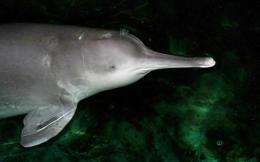Could the Yangtze River dolphin be on its way to extinction?

Last week at the global biodiversity conference in Nagoya a study revealed that one fifth of the world’s vertebrate species continue to move closer to extinction. Researchers looked at how a species’ status on the IUCN Red List of Threatened Species changed over time.
Although the study reported that no mammals were listed in the Extinct category between 1996 and 2008, the situation did worsen for the Yangtze River dolphin. The last documented sighting of the Yangtze River dolphin was in 2002, when it was photographed.
In 2006, researchers carried out an extensive search of its habitat, the Yangtze River. They also used a hydrophone to listen for the dolphin’s whistles and clicks. They could not find a single living animal.
The Yangtze River dolphin was declared functionally extinct in 2006, meaning if there are any animals still living in the wild, there may not be enough healthy individuals of the right sex to breed in sufficient numbers to save them from extinction.
It can take years of searching and reviewing evidence before the experts class a species as extinct, so the Yangtze River dolphin may stay listed as Critically Endangered for many years to come.
If the Yangtze River dolphin is declared officially extinct, it would be the first large marine mammal extinction since the Caribbean monk seal, last seen in the 1950s.
Richard Sabin, mammal expert at the Natural History Museum comments, ‘The extinction of a large marine mammal is not only a sad loss to biodiversity, it is also a shock that you cannot adequately prepare yourself for.
'As curator of marine mammals, I am at a loss to express how I feel about never being able to see the Yangtze River dolphin in the wild.’
A rare Yangtze River dolphin specimen is held as part of the Natural History Museum's research collection. The complete skull and postcranial skeleton of a female dolphin was collected from Tung Ting Lake on the Yangtze River in 1922 by Dr A Skinner, who later presented them to the Museum.
‘It is the only example of this species held by the Museum and one of only a few available to researchers in museums around the world,’ says Sabin.
‘From a scientific perspective, the research value of our specimen increases dramatically if the dolphin is declared extinct.
‘The specimen will be used to investigate the genetic make-up of the species, which will hopefully provide data that can be used to help conserve other closely-related cetacean species (whales, dolphins and porpoises).’
The Yangtze River dolphin, Lipotes vexillifer, is also known as the Baiji and Chinese river dolphin. The mammal was well adapted to its environment, using its long beak to probe the riverbed for food and echolocation to detect prey in the murky waters.
In recent times, the Yangtze River dolphin was found only in, endemic to, the Yangtze River, which is the world’s 3rd longest river at 6,300km. In the past, it had a wider distribution in the large lakes connected to the river.
The demise of the Yangtze River dolphin has been caused by incidental capture in fisheries (getting caught in nets and hooks etc), interaction with river traffic (such as boat propeller strikes), management and development of water channels (which interrupt the animal’s movement), and environmental degradation and pollution.
The IUCN Red List study highlighted how captive breeding has saved some species from extinction, such as the California condor and black-footed ferret, which were successfully reintroduced after being declared extinct in the wild. There have been attempts to capture and breed some Yangtze River dolphins but these were unsuccessful.
The Yangtze River dolphin may have been lost forever. But if new targets agreed at the Convention on Biological Diversity meeting last week to help halt the loss of biodiversity are actioned, there may be more hope for the other species and habitats currently under threat.
Provided by American Museum of Natural History















